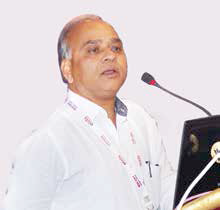
S K Kale
Chief General Manager, National Bank for Agriculture
and Rural Development (NABARD), Odisha
The major stress is on the affordable credit. All the banking facilities should be affordable, especially to the weaker section. Our focus is to provide banking services to the people at the last mile, says S K Kale. In conversation with Kartik Sharma
What is your view about the financial inclusion status in India?
Financial Inclusion is the national priority. The 12th five year plan states that the country needs the faster, sustainable and inclusive growth. That is the broader picture that we are trying to bring inclusive growth in all the sectors. From that point of view final inclusion is very important for the inclusive growth in financial sector and all other sectors.
All these financial inclusion initiatives started almost five to six years back. However it is actually not a new concept but it was started since bank were nationalized way back in 1969 and it was the great step being taken to reaching to the weaker section of the society though the word financial inclusion came into existence in 2005 by RBI. There is a global spree to bring financial inclusion because the estimate says that 2 people are out of the banking fold.

What are the major steps to be taken to expand financial inclusion?
The major stress is on the affordable credit. All the banking facilities should be affordable, especially to the weaker section. And that is our focus that how the banking services should be provided to the people unreached yet. World Bank data says that only 35 percent adults are banked and only 2 percent of them use their bank accounts for remittance like money transfer and 4 percent for government payments. 56 percent rural households are excluded. 42 percent of rural population do not avail banking services. All these facts and figures say that broadly still today 50 percent of the population is out of banking array. Government of India and Reserve Bank of India is trying its best to bring more and more people under banking purview. More and more efforts need to be taken to free the rural population from the clutches of moneylenders and other financial exploitations.
What are the major ways for inclusion and how the bank is leveraging technology for financial inclusion?
There are three major ways to bring optimal financial inclusion in the country. First is the brick and mortar model, second is the business correspondent model which is a great example of using information and communication technology in the banking and expanding financial inclusion. And lastly by the mobile bode of services, likewise banking services through through satellite offices mobile vans or mobile phones now days.

Over all there are 6 lakhs and odds villages in the country whereas the bank branches are only 70 thousand and odds. Technology initiatives taken by banks so far in the state of Odisha are that we have provided the core banking support to the week regional rural banks in the state, they are on CBS form. We also supported RRBs for the smart card models. Now the scene has been changed because now these banks have merged and now CBS of the erstwhile RRBs has to be integrated and that process is on.
Please tell us about NABARD and its objectives.
At the instance of Government of India Reserve Bank of India (RBI), constituted a committee to review the arrangements for institutional credit for agriculture and rural development (CRAFICARD) on 30 March 1979, under the Chairmanship of Shri B.Sivaraman, former member of Planning Commission, Government of India to review the arrangements for institutional credit for agriculture and rural development. The Committee, in its interim report, submitted on 28 November 1979, felt the need for a new organisational device for providing undivided attention, forceful direction and pointed focus to the credit problems arising out of integrated rural development and recommended the formation of National Bank for Agriculture and Rural Development (NABARD).
The Parliament, through Act, 61 of 1981, approved the setting up of NABARD. The bank came into existence on 12 July 1982 by transferring the agricultural credit functions of RBI and refinance functions of the then Agricultural Refinance and Development Corporation (ARDC). NABARD was dedicated to the service of the nation by the late Prime Minister Smt. Indira Gandhi on 05 November 1982.
NABARD’s mission is to promote sustainable and equitable agriculture and rural prosperity through effective credit support, related services, institution development and other innovative initiatives.
Be a part of Elets Collaborative Initiatives. Join Us for Upcoming Events and explore business opportunities. Like us on Facebook , connect with us on LinkedIn and follow us on Twitter, Instagram.











